A mid-season variety with a pleasant taste and powerful bushes - tomato "Kapia pink"
Many gardeners want to grow pink tomatoes on their site. Someone argues that such vegetables are more fortified, someone prefers the aesthetic appearance, and someone grows them because of an allergy to red tomatoes. Pink-fruited varieties are popular no less than red ones.
Of course, many gardeners have already decided on a culture that has become their favorite. For those who are still in search, we suggest that you familiarize yourself with the pink Kapia tomato. The unique color, taste and appearance characteristics of this variety have already conquered many vegetable growers and continue to attract new fans.
The content of the article
Characteristics and description of the variety
Thanks to the work of Russian breeders, the Kapia pink tomato variety was born, which in 1997 was included in the State Register of Breeding Achievements. More than 20 years have passed since then, but tomato is still in high demand among gardeners.
Distinctive features
Determinant type, but the height can reach 2 m or more. The bush is powerful and densely leafy, the leaves are elongated, dark green in color. In regions with a short and cool summer season, the culture is bred in greenhouse conditions; in the southern strip, the tomato takes root well in the open field.
The height of the main stem indicates the obligatory garter of the plant, otherwise, despite the power, the bush will not support the weight of the fruit-bearing branches.
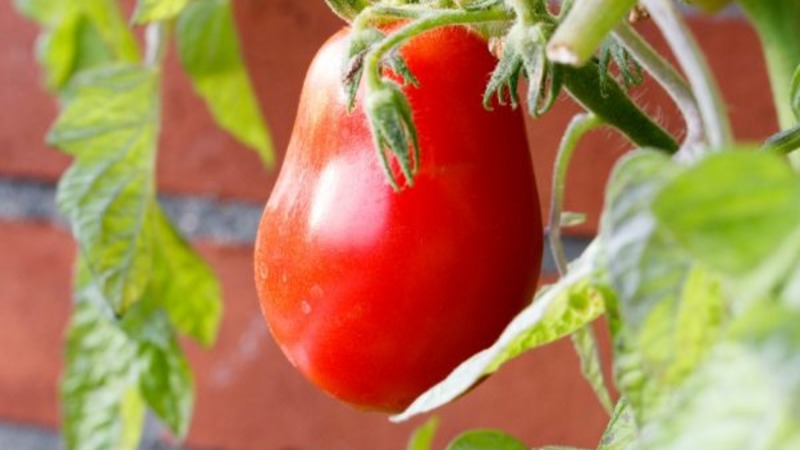
Due to the numerous lateral processes, the plants are regularly pinned, thereby eliminating the thickening of the plantings.
The ripening period is average: from the moment of emergence to the beginning of fruiting, 110-115 days pass.
Productivity is high: 1 seedling yields up to 4 kg of fruits when placed on 1 m2 no more than 3 plants.
The variety is distinguished by persistent immunity to the main diseases of the tomato series, such as: tobacco mosaic, fusarium and verticillosis.
Fruit characteristics
The average weight of tomatoes is 140–160 g, the shape is cylindrical, elongated. The appearance resembles a large drop of water. The color is deep pink, the taste is sweet with a subtle sourness. The pulp is dense, juicy, the peel is strong, not prone to cracking, due to which ripe vegetables are successfully frozen. It is believed that frozen tomatoes retain the highest amount of vitamins.
The use of vegetables is universal: they are perfect for fresh cooking and for preservation for the winter. Tomatoes are also processed into juices, pasta, adjika and lecho.
Strong skin allows ripe vegetables to keep their presentation for a long time and transport them at any distance.
The photo shows Kapia pink tomatoes.

How to grow seedlings
Sowing of seeds begins 2 months before planting in the ground. Competent preparation for this will not only increase the percentage of germination, but also strengthen the immune system.
Seed preparation
First, empty copies are separated from full ones. To do this, prepare a saline solution by dissolving 1 teaspoon of salt in a glass of water and place the grains in it for 10 minutes. Those that float to the surface are disposed of, since they will not sprout.
Then the seeds are disinfected in a weak solution of potassium permanganate for 20 minutes. Disinfection of planting material protects plants from fungal attack for a long time.After disinfection, the seeds are washed with running water.
Germination on wet gauze increases the germination rate. The fabric is slightly moistened with warm, settled water and the seeds are spread on it. After they are removed to a warm and dark place with a temperature of + 28 ° C. After 2-3 days, small sprouts will appear. This indicates the readiness of planting seeds in the ground.
reference! Since the culture does not belong to hybrid, the seed fund retains its parental properties in subsequent generations.
Capacity and soil
The landing container is treated with a solution manganese dark in color and at the bottom of each container make small drainage holes necessary for the outflow of moisture. Stagnant fluid increases the risk of fungal infections.
You can plant in a common wooden box and in separate containers. In plastic cups, seedlings are easiest to transport to summer cottages, and when grown in peat pots, minimal care is required.
reference! The peat pots in the walls contain many nutrients that the seedlings receive during their growth and development.
The soil is prepared from garden soil, peat, humus and river sand in equal proportions. The resulting mixture, like the planting containers, is disinfected with a strong manganese solution.
Sowing
The seeds are planted to a depth of 1.5 cm with a distance of 3 cm from each other. From a spray bottle, slightly moisten with warm settled water and cover with a film. Thus, they create a greenhouse effect for faster germination of seed material. The containers are left in a room with a temperature of +24 ° C.
reference! If the seeds are planted on the surface, they will sprout along with the shell, which will slow down further growth.
Seedling care
When seedlings appear, containers are placed on the windowsill. The plant needs light for 13 hours. With a lack of it, the seedlings will stretch and weaken. To prevent this, additional lighting is installed in the form of fluorescent lamps.
Watered as the upper soil layer dries up with warm, settled water from a shallow watering can. After the soil is slightly loosened.
To keep the sprouts even, without tilting, they are turned towards the light in different directions.
When 2 true leaves appear, the seedlings are dived and planted in separate containers. After that, there is an enhanced build-up of lateral roots, which contributes to the further intensive development of plants.
Before being planted in the ground, the seedlings are hardened so that they quickly get used to the new conditions. Do it outdoors at an average temperature of +17 ° C. First, the containers are left on the street for 1 hour, gradually the time is increased to 10 hours.
How to grow tomatoes

After 2 months, after the soil has warmed up, the seedlings are sent to the ground. The beds are chosen in a sunny, unshaded place without drafts. With insufficient lighting, a rich harvest cannot be obtained.
Landing
The holes are prepared in advance with a distance of 50-60 cm from each other. The seedlings are buried to the first leaves, the earth is compacted and watered with warm, settled water. After that, young bushes are left to get used to the new place, without watering or feeding.
Further care
As soon as the young seedlings take root, establish a regular watering at least 2 times a week. Use only warm, settled water, since during hypothermia, the root system can rot. In addition, cold water has a negative effect on the forming ovaries. Large barrels exposed to the sun are suitable for heating.
Drip irrigation is installed in greenhouses. With such an irrigation system, the root system is always fed only with warm water, and the moisture level does not exceed the norm.
After watering, the soil must be loosened, ensuring the air permeability of the soil. Weeds are removed from the roots. Weeds extract many nutrients from the ground and serve as a breeding ground for infections.
reference! Mulching beds help to retain moisture longer and serves as a preventive measure against pests. Straw is most often used as mulch.
From dressings, a full range of minerals or organic matter is used. Infusion of mullein, bird droppings and infusion of weeds are suitable for tomato. Also, the culture responds well to the introduction of wood ash.
During flowering, a full complex of minerals with a predominant content of phosphorus is introduced, and at the time of fruiting, potassium salts are added so that the fruits ripen faster.
Important! Organic compounds are used only in low concentration: 1:15. Strongly concentrated solutions can burn the root system.
Features of cultivation and possible difficulties
According to gardeners, seedlings achieve the highest yield when plants are formed in 2 stems. One stepson is left over the first flower brush, all the rest are removed. If this is not done, the bush will consume nutrients for the growth of unnecessary branches, and the fruits will form small and dull in color.
Stepson culture early in the morning so that the cut sites have time to heal by the evening. To prevent microbes from getting into the wounds, they are treated with a weak solution of manganese.
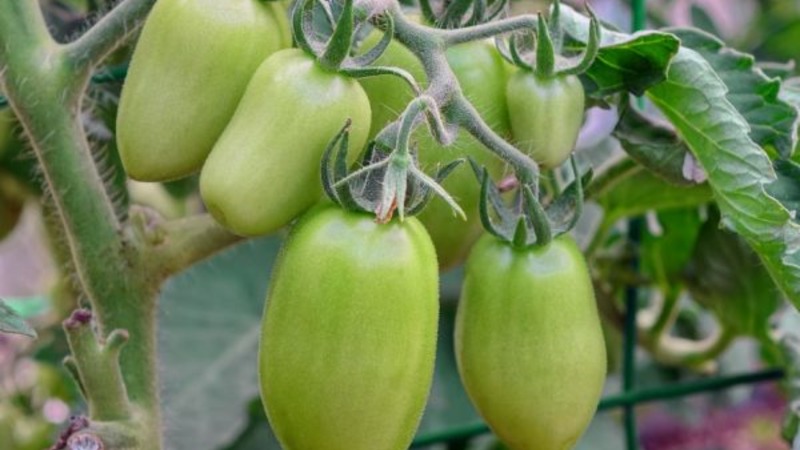 To form an even and powerful trunk, a wooden or metal support is installed next to each seedling, to which the stem is tied almost immediately after transplanting. As they grow, the fruitful branches are also fixed to the support so that they do not break under the weight of their own gravity.
To form an even and powerful trunk, a wooden or metal support is installed next to each seedling, to which the stem is tied almost immediately after transplanting. As they grow, the fruitful branches are also fixed to the support so that they do not break under the weight of their own gravity.
For fixation, in addition to vertical supports, a trellis is used. For this, metal rods are installed on two opposite sides of the beds and a wire is pulled horizontally between them. The stem and branches of the bush are fixed to it with soft ribbons. This type of garter belt is considered less traumatic.
Diseases and pests
The culture has such a strong immunity against viral and fungal diseases that it does not even need regular preventive measures. This does not mean at all that you need to forget about loosening, mulching, hilling and regular watering. Carrying out all these mandatory actions, it is not necessary to additionally spray with antifungal agents.
When transplanting, experienced gardeners treat the seedlings with a weak solution of manganese so that they do not get sick, while all forces are directed to adapting to new conditions.
Whitefly butterfly is the most dangerous pest for Pink Capia... Harm is caused not only by adults, but also by their larvae. To combat insects, plants are sprayed with an infusion of onion peels, pungent-smelling herbs (marigolds, calendula) are planted next to tomatoes and pheromone traps are set. In case of a large accumulation of the pest, insecticides "Confidor" or "Aktara" are used.
reference! Pheromone traps can be purchased at any specialty store.
Greenhouse and open field cultivation
It is convenient to plant in a checkerboard pattern not only in a greenhouse, but also in open beds. Plants do not shade each other and are well ventilated, which reduces the risk of infections.
Closed structures are recommended to be ventilated every day so that the temperature and humidity do not rise in them. At standard rates, infections will not develop. Fresh air destroys the habitat of greenhouse pests such as spider mites.
With high growth, the crown of the plant is pinched, and the seedlings consume nutrients for the forming ovaries, and not for further growth.
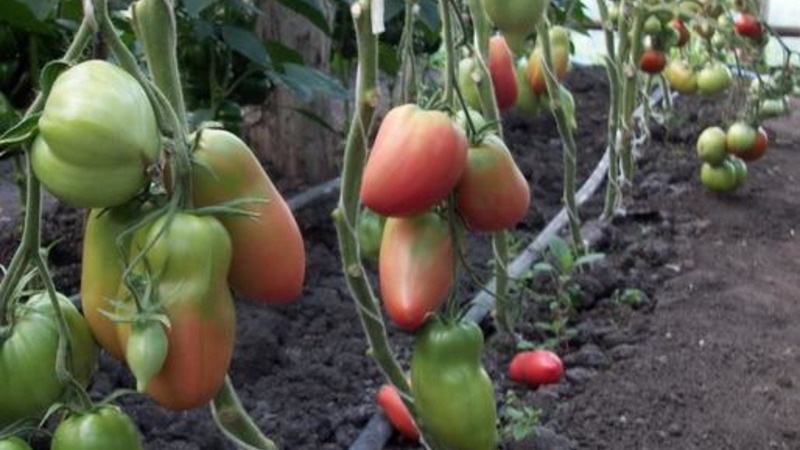 When breeding in greenhouse conditions, drip irrigation is used. A plastic bottle without a bottom is installed in the root zone and filled with water. The fact is that the culture needs only warm water, due to which the humidity and temperature will constantly increase in the greenhouse. This can trigger the development of a fungal infection that quickly spreads to all plants.
When breeding in greenhouse conditions, drip irrigation is used. A plastic bottle without a bottom is installed in the root zone and filled with water. The fact is that the culture needs only warm water, due to which the humidity and temperature will constantly increase in the greenhouse. This can trigger the development of a fungal infection that quickly spreads to all plants.
If potatoes or peppers are planted next to a tomato in the neighborhood, it is necessary to regularly carry out prevention of all plants. These cultures belong to the same family and suffer from the same diseases. Potato diseases can spread to tomatoes and vice versa. Therefore, in such a neighborhood, regular preventive measures are required.
Harvesting and application of the crop
Fruit ripening is amicable, they are cut with whole brushes. Ripe vegetables do not overload the bush, as they are evenly distributed. Tomatoes have good keeping quality and can withstand long-term transportation. Therefore, the variety is popular among farmers.
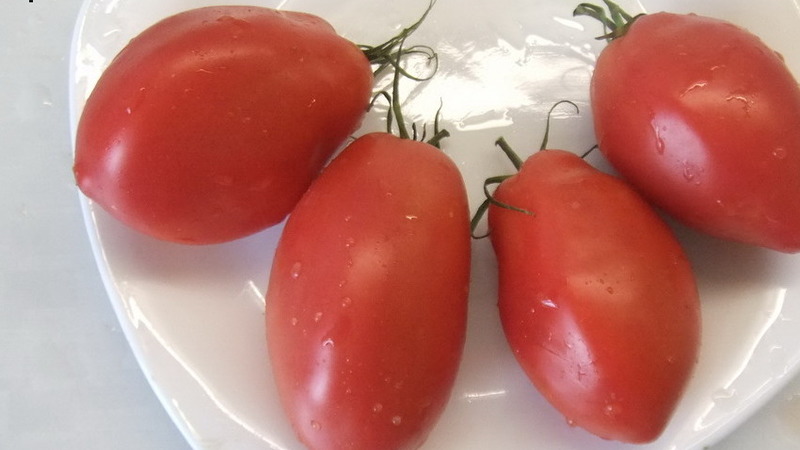 The use of vegetables is universal. All kinds of fresh dishes and winter preparations are obtained from them. Tomatoes do not crack during heat treatment, therefore they are suitable for conservation... Fruits have nutritional value when frozen, as they retain most of the vitamins.
The use of vegetables is universal. All kinds of fresh dishes and winter preparations are obtained from them. Tomatoes do not crack during heat treatment, therefore they are suitable for conservation... Fruits have nutritional value when frozen, as they retain most of the vitamins.
Also, delicious juices are obtained from ripe vegetables, not only canned, but also freshly squeezed. For a richer color, pink tomatoes are mixed with red ones.
Advantages and disadvantages
The advantages include the unusual shape of the fruit, which is clearly visible in the photographs. In addition to its appearance, the variety has other advantages:
- the opportunity to take root in all regions;
- the ability to form ovaries in any conditions;
- unpretentious care;
- high productivity;
- immunity to diseases;
- great taste;
- long-term storage;
- long distance transportation.
The disadvantages include regular pinching, mandatory garter and bush formation.
Farmers reviews
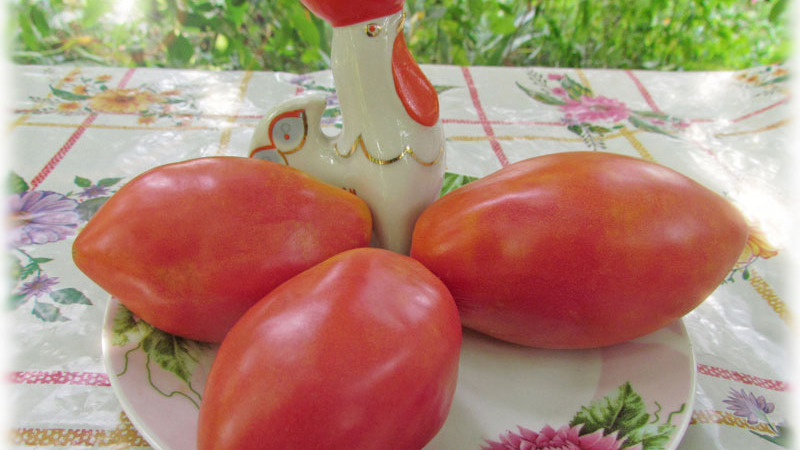
Most of the reviews about the tomato are positive, which indicates that it is easy to care for and high-quality products. Here are some opinions:
Evgeniya, Ryazan: “I planted a tomato for the first time, paid little attention to it, but the seedlings did not hurt at all and gave a magnificent harvest. The result surprised me so much that there was a desire to grow it in the future. The fruits on the bush were even and medium in size. Especially pleased with the taste. It is original and significantly different from other tomatoes. "
Elena, Saratov: “My seedlings have reached 2 m in the open field. The plants are strong and spreading. Stepson did not often, paid the main attention to the garter. The vegetables ripened quickly, very tasty. But it turned out to be even tastier when frozen. After thawing, they are soft and sweet. I will definitely plant it for freezing. "
Conclusion
To choose the optimal crop for growing, gardeners are guided by the main indicators - the complexity of care and yield. Tomato Kapia pink is characterized by ease of care and produces from 1 bush to 4 kg of fruits.
The variety is distinguished by its increased resistance to diseases, which is especially appreciated especially in the southern regions. Juicy and healthy tomatoes are suitable for summer dishes and winter preparations, are rich in vitamins and are hypoallergenic.